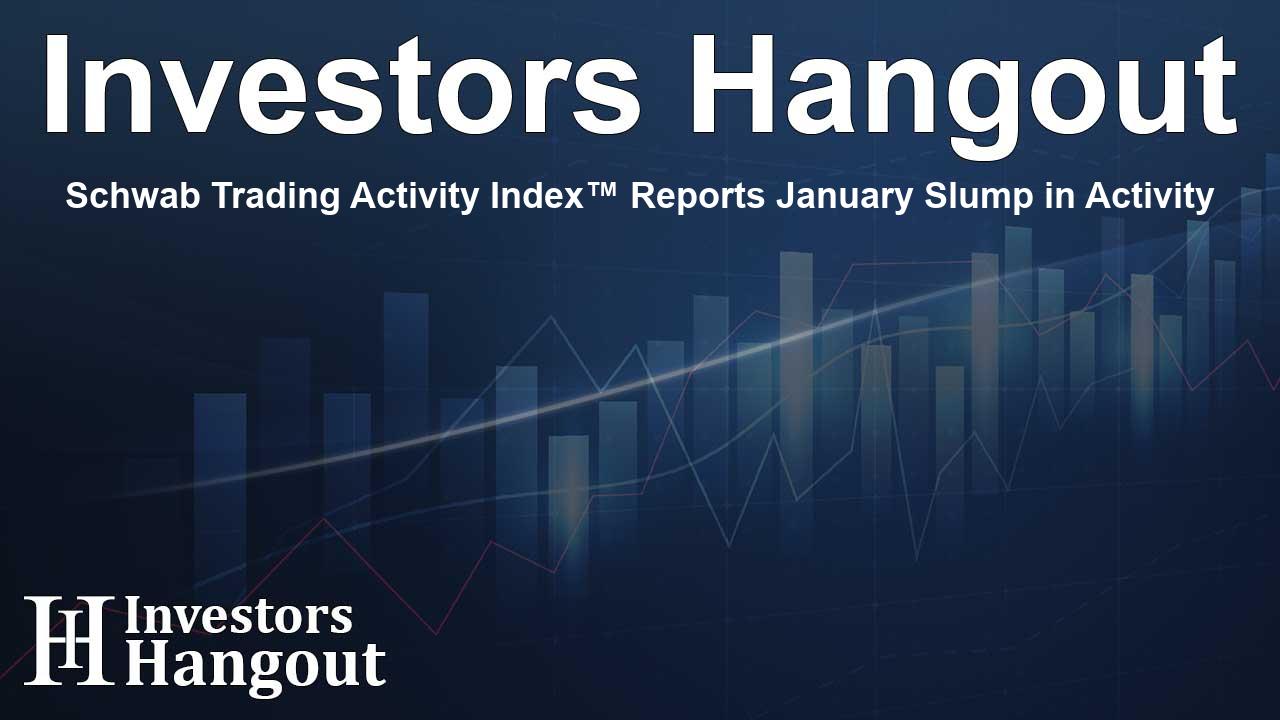Schwab Trading Activity Index™ Reports January Slump in Activity

Schwab Trading Activity Index™ Reports January Slump in Activity
The Schwab Trading Activity Index™ (STAX) saw a decrease to 49.45 in January, down from 51.16 in December. This index uniquely analyzes retail investor stock positions and trading behaviors from Schwab’s vast client base, helping to shed light on actual investor activities and market positioning each month.
Investor Behavior in January
During the four-week period ending January 31, 2025, the STAX reading was classified as 'moderate low' when compared to historical averages. This shift suggests a more conservative stance from investors as they navigated through a month filled with mixed economic signals.
Joe Mazzola, Head Trading & Derivatives Strategist at Charles Schwab, stated, “Schwab clients adopted a relatively defensive approach in January.” He noted that many investors shifted away from higher-beta stocks in response to varied news and economic indicators. Unlike last summer's buying spree during market dips, there was less enthusiasm among clients to purchase on declines this January, although some capitalized on lower prices of AI stocks towards the month's end.
Market Overview and Influences
January started on a shaky note for the S&P 500, which dropped nearly 1% from its December close amidst concerns about inflation. The benchmark 10-year Treasury note yield peaked at a 14-month record of 4.8% on January 14, potentially driven by market speculations regarding tariff policies and immigration plans from the new presidential administration, alongside the Federal Reserve's hawkish stance from its last meeting.
The sentiment shifted following the release of calmer December inflation data, leading to a temporary market rebound as it became clear that no immediate tariffs would be enacted against imports from China and other regions. Strong earnings reports from major players across various sectors, including banks and technology firms, also supported recovery in late January, with the 10-year yield tapering below 4.6%.
End of January Dynamics
However, by the end of January, the S&P 500 faced another decline of about 1% following the Federal Reserve's January FOMC meeting, which indicated a pause in anticipated rate cuts. News relating to China’s DeepSeek AI technology adversely affected tech stocks linked to the AI sector, causing further fluctuations in market sentiment.
The early January downturn was accompanied by a notable rise in market volatility, with the Cboe Volatility Index (VIX) peaking just above 22 on January 13, coinciding with the S&P 500 hitting an intraday low due to these uncertainties. Restrictions placed on U.S. chip exports at the start of the month added further pressure on technology stocks, exacerbating market volatility just prior to the release of inflation figures for December, which ultimately turned out to be mild.
Popular Stocks and Trends
Data indicated relative stability later in January as inflation figures from major banks correlated with positive earnings reports. Clients of Schwab leaned towards purchasing stocks such as:
- NVIDIA Corp. (NVDA)
- Palantir Technologies Inc. (PLTR)
- Apple Inc. (AAPL)
- Tesla Inc. (TSLA)
- Microsoft Corp. (MSFT)
Conversely, stocks that experienced a net sell-off included:
- Walt Disney Co. (DIS)
- Boeing Co. (BA)
- Bank of America Corp. (BAC)
- Walgreens Boots Alliance Inc. (WBA)
- Starbucks Corp. (SBUX)
Understanding the STAX
The STAX is determined through a robust and intricate proprietary methodology. Each month, Schwab selects a representative sample of its client base, which includes accounts that conducted trades within the preceding month. An analysis of this statistically significant sample's holdings and trading sessions results in individual scores, with the median representing the monthly STAX.
About Charles Schwab
At Charles Schwab, the philosophy centers around empowering individuals through investing to foster a better future. The firm has consistently aimed to reform the industry, delivering innovations that serve investors, their advisors, and the employers they support. Schwab passionately champions client goals with integrity and dedication.
For additional insights about Charles Schwab and its offerings, visit their website and stay updated through their social media channels.
Frequently Asked Questions
What is the Schwab Trading Activity Index™?
The Schwab Trading Activity Index™ (STAX) is a monthly index that gauges retail investor activity and sentiment based on client trading behaviors at Schwab.
What was the STAX score for January?
The STAX score for January was recorded at 49.45, indicating a decrease from the previous month.
Why did investors adopt a cautious approach in January?
Investors responded to mixed economic reports and fluctuating market conditions, leading to a more defensive trading strategy than in previous periods.
Which stocks were popular among Schwab clients in January?
Popular stocks included NVIDIA, Palantir, Apple, Tesla, and Microsoft, indicating a preference for technology and innovative companies.
How is the STAX calculated?
The STAX is calculated using a proprietary formula based on a representative sample of Schwab client accounts that have traded within the last month.
About The Author
Contact Lucas Young privately here. Or send an email with ATTN: Lucas Young as the subject to contact@investorshangout.com.
About Investors Hangout
Investors Hangout is a leading online stock forum for financial discussion and learning, offering a wide range of free tools and resources. It draws in traders of all levels, who exchange market knowledge, investigate trading tactics, and keep an eye on industry developments in real time. Featuring financial articles, stock message boards, quotes, charts, company profiles, and live news updates. Through cooperative learning and a wealth of informational resources, it helps users from novices creating their first portfolios to experts honing their techniques. Join Investors Hangout today: https://investorshangout.com/
The content of this article is based on factual, publicly available information and does not represent legal, financial, or investment advice. Investors Hangout does not offer financial advice, and the author is not a licensed financial advisor. Consult a qualified advisor before making any financial or investment decisions based on this article. This article should not be considered advice to purchase, sell, or hold any securities or other investments. If any of the material provided here is inaccurate, please contact us for corrections.
